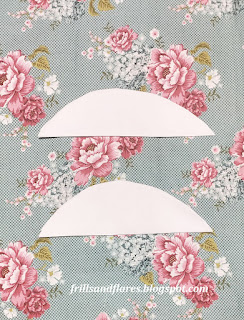The reversible A-line dress for 18-inch dolls has a simple A-line silhouette, which is narrow at the top and flares out gently to the hem), creating a clean, classic shape that is easy to sew and comfortable for the doll.
The dress can be worn inside out, showcasing two different fabric patterns or colors. This makes it two outfits in one, providing versatility and style for your doll.
All seams are hidden between the two fabric layers for a polished finish.
It's easy and quick to make—great for beginners.
It's perfect for dressing 18-inch dolls like American Girl, Our Generation, or similar dolls. I have added some extra ease to make this dress a loose-fit one.
You can trim the hemline, if you want to shorten the length of the dress.
Click the link below to browse all the free PDF sewing patterns for women:
Here's a free PDF sewing pattern and sewing tutorial to make a reversible A-line dress for an 18-inch doll.
Materials Needed
1. Fabric: Two contrasting pieces of lightweight fabric (1/4 yard each).
2. Thread: Matching both fabrics.
3. Sewing machine (or needle for hand stitching).
4. Scissors or rotary cutter.
5. Pins or clips.
6. Pattern: Link for the free PDF pattern is given below.
7. Fasteners: Velcro strips or snaps,
Download Link:
Reversible A-Line Dress for 18-Inch Dolls---Free PDF Sewing Pattern
Print the pages on A4-size papers. Make sure you have set page sizing to "Actual size" before you print the pattern.
Do not select the "Custom scale" option or the "Choose paper size by PDF page size" option.
You can measure the 1 inch x 1 inch square in the pattern page to check whether the page has printed correctly.
Pattern Assembly:
There are 4 pages in the pattern, which should be arranged as in the diagram below:
The pattern includes:
The dress front.
The dress back, split for the closure.
Seam and Hem Allowances:
Seam and hem allowances are included in the pattern. It's 1/4 inch for the neckline, back closures, and armholes, and 1/2 inch for the sides and the hemline.
Cut out the pattern templates.
Cut the Fabric
Lay out the fabric pieces and pin your pattern.
Cut out two identical dress pieces from each fabric.
Cut 1 front piece on the fold, each from the main fabric and lining fabric.
Cut 2 back pieces, each from the main fabric and lining fabric.
Cut the neck and armholes precisely.
How to Sew?
1. Pin and Sew Shoulder Seams
Place one fabric front and back with right sides together, aligning shoulder seams. Pin or clip in place.
Repeat for the second fabric.
Sew the shoulder seams on both, leaving edges raw for now.
Open the seams and press them flat.
2. Sew the Neckline and Armholes
Place the two dress pieces right sides together. Pin or clip around the neckline and back closures.
Sew around the neckline and back closures using a ¼-inch seam allowance.
Next, pin the armholes of the main and lining together.
Sew around the armholes using a ¼-inch seam allowance.
3. Turn the Dress Inside Out
Trim seam allowances and clip curves where necessary (especially at the neckline and armholes) for smooth turning.
Turn the dress right side out through the hem opening. Use a chopstick or similar tool to push out seams.
4. Sew Side Seams
With the dress inside out (with main fabric pieces together and lining fabric pieces together), pin the side seams of the dress and sew in one continuous seam on each side.
5. Finish the Hem
Turn the dress to the wrong side and sew the raw edges at the bottom hem of both fabric layers together with a 1/4 inch seam to close the hem, while leaving a small gap. Press and top-stitch around the hem.
6. Add the Closure
Add Velcro or snaps to the back of the dress for easy dressing. Alternatively, sew buttonholes and attach buttons.
---
Customization Ideas
Add a ruffle or decorative trim at the bottom of the hem.
Embellish with fabric flowers or tiny appliqués.
Make the reversible sides in contrasting patterns for versatility.
Hope you enjoy sewing for your doll!
I have posted lots of free PDF printable sewing patterns on this page on my blog. Browse through this page to find the patterns you are looking for. You can download and use them to make your own clothes.


















































































